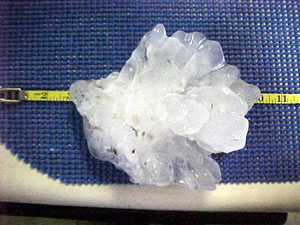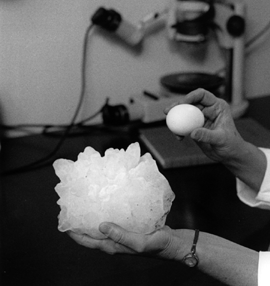|
Hail Facts
Some facts about hail. Largest Hail stone

The largest hailstone ever recovered in the United States, was 17.8 centimeters in diameter (seven inches) and a circumference of 47.6 centimeters (18.75 inches). This monster fell in Nebraska on June 22 2003, that is nearly the size of a Soccer ball. Quick thinking locals who found the hailstone, kept it from melting by sticking it in there freezer. The National Climate Extremes Committee, which is responsible for validating national records, formally accepted the measurements. The hailstone is now at the National Center for Atmospheric Research in Boulder, Colorado, where it will be preserved indefinitely.
Heaviest Hail stone

The hail stone that holds the record for the heaviest recorded in the USA, was found in Coffeyville, Kansas, on September 3, 1970. Weighing in at 0.75 kilograms (1.67 pounds) it had a diameter of 14.4 centimeters (5.67 inches), a circumference of 44.5 centimeters (17.5 inches). Coffeyville was also where the Dalton gang met there match, for those history buffs. Large hailstones can fall at speeds faster than 160 kilometers (100 miles) per hour and can sometimes contain foreign matter, such as pebbles, leaves, twigs, nuts, and insects. Hail causes nearly one billion dollars in damage every year to property and crops in the USA alone. The costliest United States hailstorm was in Denver, Colorado, July 11, 1990. Total damage was 625 million dollars (U.S.). Did you know that Terms Like Baseball size, golf ball size etc... are all official terms associated with hail size. It's not some arbitrary size, but actually a standard used by all meteorologists in the US.
Return from hail facts to Global weather
|
